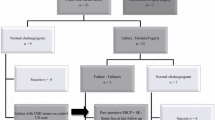Abstract.
A retrospective study was performed of 250 patients with cholelithiasis treated at the Royal Children's Hospital, (RCH) Melbourne, over 25 years by open operation; 32 (12.8%) had proven choledocholithiasis on either preoperative imaging, operative cholangiography (OpCG), or postoperative investigation. A further 3 had underlying congenital biliary abnormalities and were excluded from further study. Thirty-one of the 32 were explored at open operation, 27 after OpCG and 4 on clinical grounds. One retained common-bile-duct (CBD) stone was undetected until the postoperative period (1/250, 0.25%). Seven ducts were not cleared, giving a duct exploration failure rate of 22.6% (7/31). All 8 retained CBD stones were identified in the early postoperative period and managed with a variety of techniques, including endoscopic retrograde cholangio-pancreatography (ERCP). The incidence of retained stones after open CBD exploration was high (22.6%), and can be attributed to difficulties in operative technique dealing with the smaller paediatric CBD. In addition, haemolytic disease seems to induce a propensity for choledocholithiasis. Given the small numbers presenting with cholelithiasis to RCH (10 per year), it is suggested that a selective approach to CBD exploration is appropriate in children. With the increasing use of laparoscopic cholecystectomy in children and the inherent technical difficulties of laparoscopic operative cholangiography, ERCP may offer an alternative solution in dealing with CBD stones rather than open or laparoscopic CBD exploration.
Similar content being viewed by others
References
Gibson J (1925) Medical essays and observations. Quoted by Synder CC In: Cholecystitis and cholelithiasis in young children. JAMA 85: 31
Schwei GP (1958) Cholecystitis with cholelithiasis in childhood. Wis Med J 57: 295–298
Pieretti R, Auldist AW, Stephens CA (1975) Acute cholecystitis in children. Surg Gynecol Obstet 140: 16–18
Porkorny WJ, Saleem M, O'Gorman RB, McGill CW, Harberg FJ (1984) Cholelithiasis and cholecystitis in childhood. Am J Surg 148: 742–744
Harned RK, Babbitt DP (1975) Cholelithiasis in childhood. Radiology 117: 391–393
Man DWK, Spitz L (1985) Choldocholithiasis in infancy. J Pediatr Surg 20: 65–68
Holcomb GW (1993) Laparoscopic cholecystectomy. Semin Pediatr Surg 2: 159–167
Lugo-Vicente HL (1997) Trends in management of gallbladder disorders in children. Pediatr Surg Int 12: 348–352
Hall RC, Sakiyalak P, Seuk KK, Rogers LS, Webb WR (1973) Failure of operative cholangiography to prevent retained common duct stones. Am J Surg 125: 51–63
Witcombe JB, Cremin BJ (1978) The width of the common bile duct in childhood. Pediatr Radiol 7: 147–149
Henzel JH, DeWeese MS (1971) Common duct exploration with and without balloon-tipped biliary catheters. Arch Surg 103: 199–203
Knight CD (1967) Use of balloon-tipped catheter in exploration of the common duct. Am J Surg 113: 717–718
Rhodes M, Nathanson L, O'Rourke N, Fielding G (1995) Laparoscopic exploration of the common bile duct: lessons learned from 125 cases. Br J Surg 82: 666–668
Newman KD, Powell DM, Holcomb GW (1997) The management of choledocholithiasis in children in the era of laparoscopic cholecystectomy. J Pediatr Surgery 32: 1116–1119
Rescorla FJ, Plumley DA, Sherman S, Sherer LR, West KW, Grosfeld JL (1995) The efficacy of early ERCP in pediatric pancreatic trauma. J Pediatr Surg 30: 336–340
Tagge EP, Tarnasky PR, Chandler J, Tagge DU, Smith C, Hebra A, Hawes RH, Cotton PB, Othersen HB (1997) Multidisciplinary approach to the treatment of pediatric pancreaticobiliary disorders. J Pediatr Surg 32: 158–164
Guelrud M (1996) Endoscopic retrograde cholangiopancreatography in children. Gastroenterologist 4: 81–97
Ohnuma N, Takhishi H, Tanabe M, Yoshida H, Iwai J (1997) Endoscopic retrograde cholangiopancreatography in biliary tract disease in infants less than one year old. Tohoku J Exp Med 181: 67–74
Kim PC, Wesson D, Superina R, Filler R (1995) Laparoscopic cholecystectomy versus open cholecystectomy in children: which is better? J Pediatr Surg 30: 971–973
Pencev D, Brady PG, Pinkas H, Boulas J (1994) The role of ERCP in patients after laparoscopic cholecystectomy. Am J Gastroenterol 89: 1523–1527
Rescorla FJ (1997) Cholelithiasis, cholecystitis, and common bile duct stones. Curr Opin Pediatr 9: 276–282
Sees DW, Martin RR (1997) Comparison of preoperative ERCP and laparoscopic cholecystectomy with operative management of gallstone pancreatitis. Am J Surg 174: 719–722
Taylor OM, Sedman PC, Jones BM, Royston, CM, Arulampalam T, Wellwood J (1997) Laparoscopic cholecystectomy without operative cholangiogram: 2038 cases over a five year period in two district general hospitals. Ann R Coll Surg Engl 79: 376–380
Acknowledgements.
The authors wish to thank all 11 surgeons, past and present, from the Royal Children's Hospital, Melbourne, for the use of their patient data in this study and particularly thank current surgeons A.W Auldist, K.B. Stokes, and R.G. Taylor.
Author information
Authors and Affiliations
Corresponding author
Rights and permissions
About this article
Cite this article
Farrow, G.B., Dewan, P.A., Taylor, R.G. et al. Retained common-duct stones after open cholecystectomy and duct exploration in children. Ped Surgery Int 19, 525–528 (2003). https://doi.org/10.1007/s00383-002-0766-7
Accepted:
Published:
Issue Date:
DOI: https://doi.org/10.1007/s00383-002-0766-7




